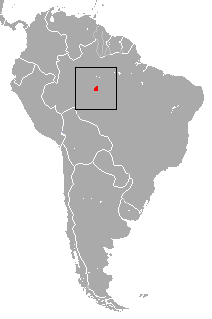
Asuras are a class of beings or power-seeking clans related to the more benevolent Devas in Hinduism.
Hindu deities are the gods and goddesses in Hinduism. The terms and epithets for deity within the diverse traditions of Hinduism vary, and include Deva, Devi, Ishvara, Ishvari, Bhagavān and Bhagavati.

Cumulus humilis are cumuliform clouds with little vertical extent, common in the summer, that are often referred to as "fair weather cumulus". If they develop into cumulus mediocris or cumulus congestus, thunderstorms could form later in the day.

Deva means "heavenly, divine, anything of excellence", and is also one of the terms for a deity in Hinduism. Deva is a masculine term; the feminine equivalent is Devi.

The Roosmalens' dwarf marmoset, also known as the black-crowned dwarf marmoset, is a small New World monkey native to the Amazon Rainforest, on the east bank of the lower Madeira River, and the west bank of the Aripuanã River, in Brazil. It has the smallest distribution of any primate in Amazonia. This marmoset has several unique attributes, which has resulted in it sometimes being placed in the monotypic genus Callibella. However, genetic analysis has subsequently resulted in its being classified within the genus Mico.

A daeva is a Zoroastrian supernatural entity with disagreeable characteristics. In the Gathas, the oldest texts of the Zoroastrian canon, the daevas are "gods that are rejected". This meaning is – subject to interpretation – perhaps also evident in the Old Persian "daiva inscription" of the 5th century BCE. In the Younger Avesta, the daevas are divinities that promote chaos and disorder. In later tradition and folklore, the dēws are personifications of every imaginable evil.

Chamaerops is a genus of flowering plants in the family Arecaceae. The only currently fully accepted species is Chamaerops humilis, variously called European fan palm or the Mediterranean dwarf palm. It is one of the most cold-hardy palms and is used in landscaping in temperate climates.

Rena humilis, known commonly as the western blind snake, the western slender blind snake, or the western threadsnake, is a species of snake in the family Leptotyphlopidae. The species is endemic to the southwestern United States and northern Mexico. Six subspecies are currently recognized, including the nominate subspecies described here.

The Samudra Manthana is one of the best-known episodes in the Hindu philosophy narrated in the Bhagavata Purana, in the Mahabharata and in the Vishnu Purana. The Samudra Manthana explains the origin of Amrita, the nectar of immortality and the omnipotent god of destruction Shiva drank the vish.

An asura in Buddhism is a demigod or titan of the Kāmadhātu. They are described as having three heads with three faces each and either four or six arms.

Ruellia humilis is a species of flowering plant in the family Acanthaceae. It is native to the eastern United States. It is grown as an ornamental plant.
The Kālakeyas or Kālakhañjas are a class of Asura in Hindu mythology. They were a powerful, ferocious and cruel clan of the Dānavas.

Grevillea linearifolia is a shrub endemic to New South Wales, Australia.

Asura is a genus of moths in the subfamily Arctiinae erected by Francis Walker in 1854.

Lyclene is a genus of lichen moths of the family Erebidae, subfamily Arctiinae. The genus was erected by Frederic Moore in 1860.

Asura's Wrath is an action video game developed by CyberConnect2 and published by Capcom. Asura's Wrath was first announced at the Tokyo Game Show in 2010, and was released worldwide in February 2012. The game is playable on PlayStation 3, Xbox 360, Xbox One via 360 backwards compatibility, and the PlayStation 4 and PC via PlayStation Now.

Acropora humilis, also known as finger coral, is a species of acroporid coral found in the Gulf of Aden, the Red Sea, the northern and southwestern Indian Ocean, Australia, the central Indo-Pacific, Japan, southeast Asia, the East China Sea, the central and western Pacific Ocean, the Johnston Atoll and the northwestern Hawaiian Islands. It also occurs in the Raja Ampat Islands, Mariana Islands, Palau, and the Pitcairn Islands. Occurring in tropical shallow reefs on upper reef flats and slopes at depths of up to 12 metres (39 ft), it was described by Dana in 1846.
Isocoma humilis, common names Zion goldenbush or Zion jimmyweed, is a rare North American plant species in the sunflower family. It has been found only in southern Utah in the United States. Some of the populations lie inside Zion National Park.
Grevillea humilis is a shrub of the family Proteaceae native to New South Wales. Three subspecies are recognised.

Trachycarpeae is a tribe of palms in subfamily Coryphoideae of the plant family Arecaceae. It has the widest distribution of any tribe in Coryphoideae and is found on all continents, though the greatest concentration of species is in Southeast Asia. Trachycarpeae includes palms from both tropical and subtropical zones; the northernmost naturally-occurring palm is a member of this tribe. Several genera can be found in cultivation in temperate areas, for example species of Trachycarpus, Chamaerops, Rhapidophyllum and Washingtonia.














